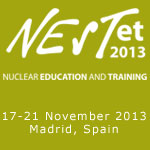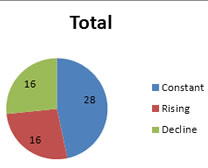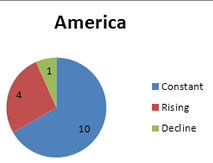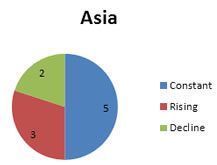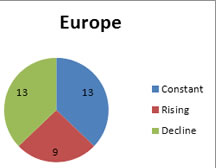
Is there still a Fukushima impact on university enrollment?
M. Salletmaier1, Rustam K* 2 J. Bannon3, H. Böck1
Abstract:
Nuclear education has seen many ups and down since the birth of nuclear technology. Nuclear education, along with nuclear technology, witnessed its peak during the 1960s due to the very high support it received from all stakeholders. In the 1970s, the development of nuclear power technology was severely damaged by local and global nuclear accidents. The Chernobyl nuclear disaster in 1986 helped to further deteriorate the situation for nuclear education, especially in industrialised countries like Germany. During the late 1990s it was believed that the amount of nuclear knowledge would decrease significantly if no counter measures were taken to arrest the declining situation facing nuclear education. Many local, regional, and international efforts were coordinated to restore a proper system of nuclear education. These painstaking efforts regenerated the nuclear education system, but the Fukushima nuclear disaster in 2011 seems to be creating serious obstacles for the restoration of nuclear education in many counties. This research article studies the influence that Fukushima had on nuclear education. For this purpose a worldwide survey based on a well-designed questionnaire was conducted to gather as much information as possible about the trends affecting nuclear education. This questionnaire collected student enrollment data from 2007 to 2012. It was distributed to 210 different institutions in 57 countries that either already have nuclear power programmes or intend to develop a nuclear programme. Out of these 210 institutions, a total of 61 responded to the questionnaire. This survey covers Europe, Asia, and the Americas. Based on these international results the following research paper highlights the impacts that Fukushima had on nuclear education programmes in the individual target countries.
1. Background
Nuclear technology relies upon nuclear knowledge. The role of nuclear education and training institutions in creating, storing and disseminating nuclear knowledge is recognised globally [1]. Nuclear education has seen its ups and downs during the development of nuclear technology. Figure 1 reflects the historical trends that have influenced nuclear education in the United States. This analysis shows that nuclear engineering programmes and departments were formed in the late 1950’s and 1960’s from interdisciplinary efforts made by many top research universities and provided the manpower needed for this technical discipline. For many of these programmes research reactors were built worldwide and began operating to facilitate research and training in the field of nuclear technology. The 1960s was the heyday for nuclear education as the trend for student enrolment and the availability of nuclear engineering programmes at universities increased sharply [1].
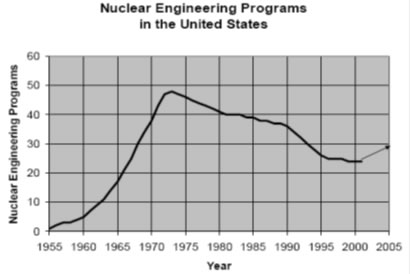
Fig. 1: Historical trends effecting nuclear engineering programmes in the United States.
The development of nuclear power technology has been severely damaged by certain local and global nuclear accidents. A serious decline in student enrolment and a lack of industry interest threatened the sustainability of nuclear technology. Issues like safety and the aging of nuclear facilities and personnel were emerging in many countries and awareness of the importance of nuclear knowledge management in addressing such issues grew significantly. Knowledge management has become an important element of the organisational behaviour of the nuclear industry. The importance of managing nuclear knowledge was recognised at a global level during the IAEA General Conference in 2002 [1], where a new resolution on nuclear knowledge that emphasised the importance of nuclear knowledge management was adopted. In Europe, it was felt that failure to take appropriate steps would seriously jeopardise the provision of adequate expertise. Much serious effort wad put in by governments, industry, and academia to restore and improve the nuclear education system [1, 3]. The improvement in student enrollment was observed in many countries [1].
2. Worldwide survey on nuclear education after Fukushima accident
The questionnaire of the study was designed to gather the most important and easily accessible information available from all universities and was filled in by most of them. To achieve this objective we asked for the following information
-
Name and country of the institution
-
Nature and length of the nuclear education programme
-
Special academic/training programme (if any)
-
Total number of applications per year
-
Student enrollment data for the current year (2012)
-
Enrollment data overlast six years (from 2007 to 2012)
-
Main employer of the graduates
-
Inclusion of the Fukushima accident in the course
-
Student interest in response to the Fukushima accident
-
Impact of the Fukushima accident onfunding
This survey questionnaire is still available at www.tinyurl.com/ATI-NKM
We also took into account the fact that some universities have more applications than places available and that enrollment numbers would, therefore, be non-representative. In these cases we replaced the number of enrolled students by the number of applicants.
2.2 Survey Results
After collecting the data from 29 different countries in Europe, Asia, and the Americas the trends in nuclear education in different regions were identified, reflecting the nature and size of their respective nuclear programmes. It has been only one and half years since the Fukushima accident, which is not long enough to predict the visible influence of the accident. The visibility of trends in nuclear education may take some more time to emerge. Fukushima affected the nuclear environment in some developed countries like Germany, Italy, Austria, Switzerland, and Japan, while in India, Pakistan, and China, public perception is still pro-nuclear and there has been a trend towards an increase in nuclear education. This section is divided into three subsections: Europe, the Americas, and Asia. Out of the 59 responses received, 40 showed complete enrollment records, 11 presented incomplete records, and 8 were unable to provide any enrollment data. It is safe to say that many universities that were contacted did not respond to the questionnaire due to lack of data.
A total of 51 universities reported no change in their budget situation due to Fukushima, 5 institutions reported a decrease in funding, and only 3 institutions saw an increase in their budgets after Fukushima. It is quite troubling to observe that almost 10% reported a decrease in funding, even though nuclear education needs more money to better train professionals.
Fig. 2: Nuclear education trends in different regions of the world
1.2.1 Europe
Before Fukushima the nuclear knowledge management landscape in Europe (EU-27) experienced a growth in variety, as well as in number of instruments and initiatives [6] on offer. The effects of Fukushima on the workforce have been significant in some countries. For example, the main changes that affected the supply/demand ratio for nuclear experts, at least at a national level, occurred in Germany (where 8 nuclear power reactors were taken off the grid and the rest will be closed by 2022), and in Italy (where, in June 2011 a referendum imposed a ban on the reintroduction of nuclear power). In some countries, new build and the replacement of nuclear reactors might have slowed down, but significant changes are not expected in other countries. The industry is still running under full capacity with regards to new build and if one considers full order books. The overall picture is variable, and a clear judgment of the consequences is extremely challenging at this moment. It is, however, clear that there is still a need for highly competent experts on nuclear safety in the EU-27, which should provide a stimulus for good job opportunities in the region for decades to come [6].
To show the real influence of Fukushima responses to the above-described questionnaire were received from 24 different institutions providing nuclear education, located in 18 European countries.
Europe is quite important for the future of nuclear since many countries have their own programmes, but do not coordinate much with one another. EHRO-N has already started to find out how flexible and mobile nuclear experts in Europe are, and how much they are willing to travel or resettle in a new location.
With somewhat contrary perceptions from both citizens and the media, the European nuclear landscape will shift and diversify. Much effort is needed to provide the proper workforce that is needed to make Europe a global player both in nuclear energy production and in R&D.
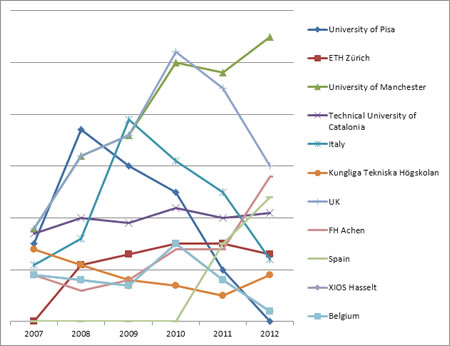
Fig. 3: Pre and post-Fukushima trends in nuclear education in some European countries
1.2.2 Asia
China, India, South Korea, Japan, and Pakistan were surveyed to investigate the influence of Fukushima on their respective nuclear education programmes. The trends in nuclear education observed in these countries are summarised in Figure 4. The graph shows completely different trends compared to those observed in European countries. This may be due to the varying nature and demands of nuclear energy in these regions.
However, following Fukushima safety issues in new nuclear power plants are being emphasised in Asian countries.
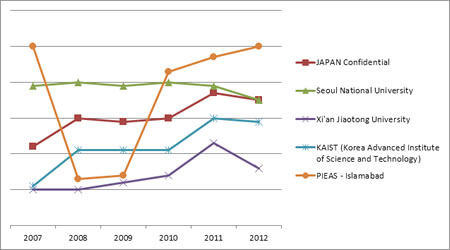
Fig. 4: Pre and post-Fukushima trends in nuclear education in some Asian countries.
Nuclear education in most Asian countries reflects the development of nuclear technology. Figure 4 presents the slightly mixed trend in nuclear education among Asian countries. Both institutions in South Korea show a slight decline, while Pakistan and Indian institutes demonstrate a slight increase.
1.2.3 America
Currently, the USA produces 19.2 percent of its electricity from nuclear energy and is in the process of granting 20-year license extensions for most of the country’s 104 operating reactors. The country will continue to obtain a significant portion of its electricity from nuclear power [10]. Fukushima has stressed the need for safety improvements and the United States has begun to take concrete steps to address serious shortcomings in nuclear plant safety and security that have been evident for years.
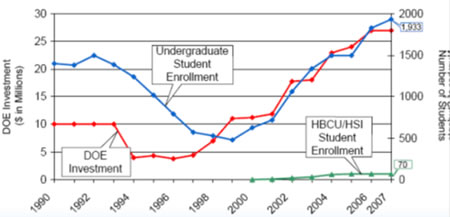
Fig. 5: Improvement in undergraduate student enrollment with DOE investment.
In the late 1990s, the USA made many efforts to imcrease its nuclear education enrollments. As a results of these efforts, student enrollment in US institutions offering nuclear education increased significantly, as can be seen in Figures 5 and 6. It is difficult to predict the real picture behind trends in nuclear education just one year after Fukushima, but the trends become more visible with time. The present survey on nuclear education indicates a gradual slowing down of student enrollment in US universities.
Nine US universities responded to the questionnaire. A response from Canada was also received, but due to a lack of enrollement data it is not included in the analysis. Figure 6 presents student enrollment trends before and after Fukushima.
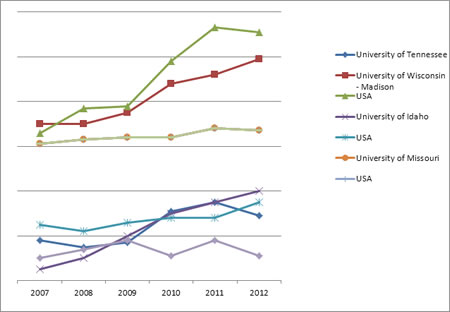
Fig. 6: Pre and post-Fukushima trends in nuclear education in the USA.
Conclusions
-
Even just one year after Fukushima there has already been a visible effect on the nuclear education enrollment numbers for universities around the world. Because Fukushima occurred, however, student enrollment data over the next 5 years will likely show an increasingly clear and significant influence on nuclear education programmes, stemming directly from the accident.
-
Survey data indicates that Fukushima resulted in a gradual slowing down of student enrollment in nuclear education programmes in many countries, rather than an immediate cancellation of programs or sudden and drastic increases or decreases in enrollment trends. This shows that the effects of Fukushima accident may not yet be fully realised and that the nuclear industry as a whole is still in the process of reacting to the accident of 2011.
Acknowledgement:
The authors are very grateful to the higher education institutions and nuclear stakeholders who responded to the questionnaire and extended their wishes for further cooperation. In case of queries or suggestions concerning the questionnaire, or our study in general, the authors would appreciate your feedback. Contact them by email at: msalletmaier@ati.ac.at
References
-
IAEA Nuclear Energy Series No. NG-T-6.1 Status and Trends in Nuclear Education“ IAEA 2011, Vienna, Austria.
-
Helmuth Böck, Education and Training in Nuclear Energy: State of the Art, need and Future Strategies, International conference on Research Reactor Fuel management (RRFM 2010), 21 -25 March 2010, Marrakech, Morocco.
-
OECD publication (2003) Nuclear Legislation in OECD Countries, ISSN 1727-3854.
-
M. Salletmaier, J. Bannon, H. Böck, R. Khan, Post Fukushima Student Enrollment Study, EHRO-N Meeting 2012, Istanbul, Turkey.
-
R. Khan, H. Böck, M. Villa, The status and patterns of nuclear education in an anti-nuclear environment, Austria, Int. J. Nuclear Knowledge Management, Vol. 4, No. 3, 2010.
-
Veronika Simonovska, Ulrik von Estorff, Putting into perspective the supply of demand for nuclear experts by 2020 within EU-27 nuclear energy sector, An EHRO-N report, JRC70083 2012, Publications Office of the European Union, Luxembourg.
-
World Nuclear Association website, www.world-nuclear.org/info/inf63.html 2011, 22a St James's Square London SW1Y 4JH, United Kingdom.
-
Rio Tinto, China to become nuclear number one, November 2012, www.news.com.au/news/china-to-become-nuclear-number-one-rio/story-fnejlrpu-1226519612061
-
Alan McDonald, Nuclear Power Global Status, IAEA website, www.iaea.org/Publications/Magazines/Bulletin/Bull492/49204734548.html
-
U.S. Nuclear Power after Fukushima, Union of concerned scientists, July 2011, www.ucsusa.org/nuclear_power
-
Vienna University of Technlogy/Atominstitute
Stadionallee 2, A-1020, Vienna, Austria
Fax: +43-1-58801-14199
Email: boeck@ati.ac.at
Email: markus.salletmaier@gmail.com
-
Pakistan Institute of Engineering and Applied Sciences (PIEAS),
P.O. Nilore, Islamabad, Pakistan
Fax: +92-51-2208070
Email: rustam@pieas.edu.pk
-
e-Squared Consulting GmbH
Parkring10/Liebenberggasse 7, 1010 Vienna, Austria
Email: jeff@esquared.at
|

